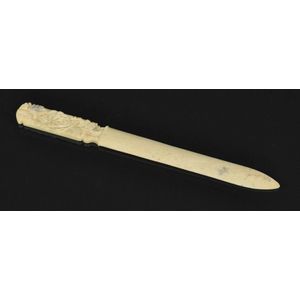Antique Chinese Ivory Page Turner
A fine antique Chinese ivory page turner, Qing Dynasty, 19th century, decorated to both sides, the principal with auspicious flora in low relief upon a diaper ground, with two small rodents to the throat, the oval handle with figures in a pavilion engaged in a narrative. Length 29 cm
You must be a subscriber, and be logged in to view price and dealer details.
Subscribe Now to view actual auction price for this item
When you subscribe, you have the option of setting the currency in which to display prices to $Au, $US, $NZ or Stg.
This item has been sold, and the description, image and price are for reference purposes only.
- Ivory - Ivory is a hard white material that comes from the tusks of elephants, mammoth, walrus and boar, or from the teeth of hippopotamus and whales. The ivory from the African elephant is the most prized source of ivory. Although the mammoth is extinct, tusks are still being unearthed in Russia and offered for sale.
Ivory has been used since the earliest times as a material for sculpture of small items, both in Europe and the east, principally China and Japan.
In Asia ivory has been carved for netsuke, seals, okimono, card cases, fan supports, animals and other figures and even as carved tusks.
In the last 200 years in Europe ivory has been used to carve figures, for elaborate tankards, snuff boxes, cane handles, embroidery and sewing accessories, in jewellery and as inlay on furniture. Its more practical uses include being used for billiard balls, buttons, and a veneers on the top of piano keys.
The use and trade of elephant ivory have become controversial because they have contributed to Due to the decline in elephant populations because of the trade in ivory, the Asian elephant was placed on Appendix One of the Convention on International Trade in Endangered Species (CITES), in 1975, and in January 1990, the African elephant was similarly listed. Under Appendix One, international trade in Asian or African elephant ivory between member countries is forbidden. Unlike trade in elephant tusks, trade in mammoth tusks is legal.
Since the invention of plastics, there have been many attempts to create an artificial ivory - Diaper Motif - The diaper motif is a repeating geometric pattern in decorative arts that consists of small diamond or lozenge shapes arranged in a grid. The pattern is often used as a background or border on textiles, ceramics, metalwork, and other decorative items. It can be found in a variety of cultures and historical periods, and is often used in formal or ornamental designs. The name "diaper" comes from the pattern's resemblance to the criss-crossed fabric of a baby's diaper.
- Qing Dynasty - The Qing Dynasty was the last imperial dynasty of China, ruling from 1644 to 1912. It was established by the Manchu people, who originated from the northeastern region of China. The Qing Dynasty was preceded by the Ming Dynasty and followed by the Republic of China.
This item has been included into following indexes:
Visually similar items

An antique ivory page turner, 19th century, the page turner of slender spatula form with a pierced and carved vegetal and stiff leaf capital. Length 27.5 cm
Sold by
in
for
You can display prices in $Au, $US, $NZ or Stg.

Chinese ivory letter opener. Carved blossom decoration to handle. Length 18 cm weight 16gms.
Sold by
in
for
You can display prices in $Au, $US, $NZ or Stg.

Ivory letter opener with carved dragon handle
Sold by
in
for
You can display prices in $Au, $US, $NZ or Stg.

Carved ivory dragon handled and painted letter opener
Sold by
in
for
You can display prices in $Au, $US, $NZ or Stg.
